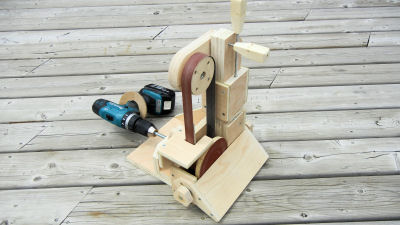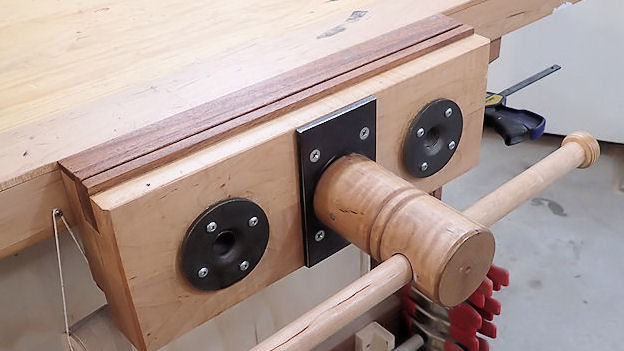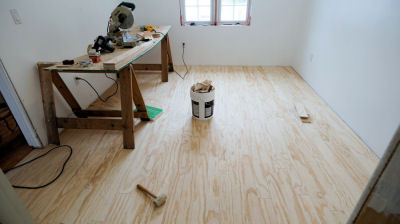Making A Modern Retro HTPC Computer Case Fun & Interesting
I’ve built a number of computer cases over the years and most of them have been the flat, home theater style as opposed to the vertical tower. The exception was my last wooden computer case, a large floor standing wooden cube case that doubles as a stand for my homemade amplifier.
This new case will house the guts from my older video editing computer (Asus CM6870) and will take the place of my big wooden computer in my living room. The big wooden computer will then be moved to the basement where I want to set up a home theater. Or, that’s the plan, anyway.
To get started, I removed the plastic parts from the old case and cut out the drive bays:
.jpg)
I will be reusing the USB / card reader / headphone jack from the front panel and putting that in the new case:
.jpg)
I cut the top 5.25″ drive bay off and installed the bay back into the case in the new location using #6 self drilling screws:
.jpg)
I had to cut another hole in the side to access the screws for mounting the drive:
.jpg)
Then I chopped a big hole through the front of the metal chassis for the card reader / USB posts. This can be sloppy and oversize, since I’ll be mounting the port in the plywood front panel itself:
.jpg)
That more or less completes the metal work on the old case.
I figured the easiest way to make the enclosure was to make the back “U” shaped and that would slip down over the chassis from the top. It would be fastened at the bottom with screws through the sides into the chassis, very much like audio receivers and amplifiers.
I used 1/4″ plywood for the top and 3/4″ for the side panels, and assembled it with glue and brads. I didn’t have a big enough piece of the thinner plywood for the top, so I had to glue two pieces together using some of my homemade clamps:
.jpg)
The front panel is also made from 3/4″ plywood and to make the holes for the drive and USB port, I cut it into sections that will be glued back together:
.jpg)
That results in much cleaner and neater holes than you could cut with a jigsaw, and it takes less time.
Originally, I was not going to use the power switch that was in the old case, but I couldn’t find anything suitable to replace it in my electronics junk. To use the old one, I drilled a 3/4″ hole through the panel and made a wooden button with a washer attached to keep it in:
.jpg)
I pushed the button all the way out, then sanded it down flush with the front:
.jpg)
I glued the old switch to a small block of wood with epoxy and I’ll be able to screw that to the metal front on the chassis where it lines up with the button:
.jpg)
Back to the button, I added a wooden spring to keep it pushed forward:
.jpg)
There is enough space between the back of the front panel and the metal front of the chassis (due to the screw heads I used to attach the drive bays) for the wooden spring to flex freely.
To fasten the plywood front panel, I could drive screws from behind, but there’s not much metal left back there to do that. Instead, I added tabs to the sides. First I had to temporarily hold the front exactly where it needs to be. I used dabs of hot melt glue that will be cut away later:
.jpg)
The tabs are just pieces of wood that are glued to the front and here I’ve rigged up a quick and dirty clamp to hold it tight to the side of the chassis while the epoxy sets:
.jpg)
After it dried, I drilled pilot holes and countersinks for small flat head screws:
.jpg)
The tabs are just the right thickness to fit between the metal chassis and the wood side panels.
With the back cover and front put on, I can mark the front to the final size. I made it slightly bigger than I needed to begin with:
.jpg)
I also cut the plastic cover for the card reader / USB ports from the old case and made it fit neatly in the hole. I did this while the epoxy was drying on the tabs:
.jpg)
I decided to cut rabbets in the front panel to make it look thinner. I figured it would look less clunky than the full 3/4″ thick plywood:
.jpg)
Since some of the back of this is visible, I had to veneer that as well:
.jpg)
While the contact cement was drying on one thing, I could do another and got the back cover done at the same time. I cut the veneer from a single piece so that the grain was continuous up and over:
.jpg)
The edges of the front are done next:
.jpg)
And then the front. I drilled a 3/4″ hole through the veneer for the power switch button before gluing it on:
.jpg)
Then I gave it a coat of linseed oil to see how it looks, I cut a piece of black plastic (again from the old case) and epoxied that to the switch button:
.jpg)
Unfortunately, after I put it together I didn’t like how it looked – too much of the same veneer. The odd thing is that never even occurred to me before I did it:
.jpg)
I considered several things I could do to change it, like using a different veneer on the front, or covering it with aluminum, but in the end I decided to paint the front black. I know, that seems like a total waste (and it is), but I need to be somewhat satisfied with results and the veneer wasn’t doing it.
Moving onwards, I needed to make “L” shaped fillers to go between the chassis and the plywood sides, and I used construction adhesive to attach those:
.jpg)
Spring clamps hold it together until the glue sets:
.jpg)
I also used construction adhesive to glue in the card reader / USB ports:
.jpg)
.jpg)
And here’s how it looks when assembled:
.jpg)
.jpg)
.jpg)
.jpg)
.jpg)
The rear:
.jpg)
To attach the cover to the chassis, I drilled a 3/8″ counterbore, then drilled and tapped for #10 machine screws:
.jpg)
With the parts installed:
.jpg)
Still missing the system drive, since that is currently in my big wooden computer case. As shown, everything fits neatly and there’s still room for more hard drives if I need them in the future:
.jpg)
Here’s the build video:















